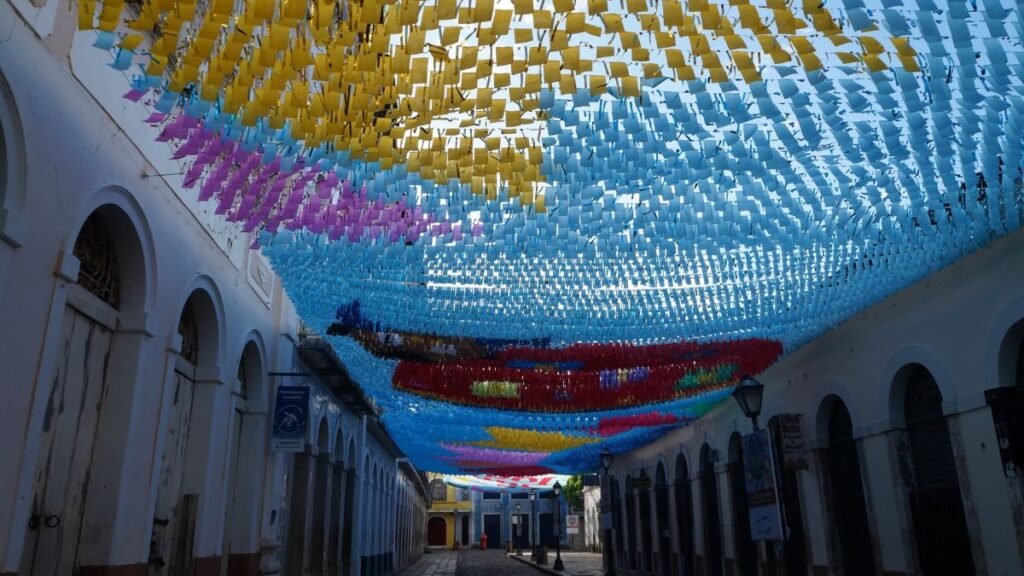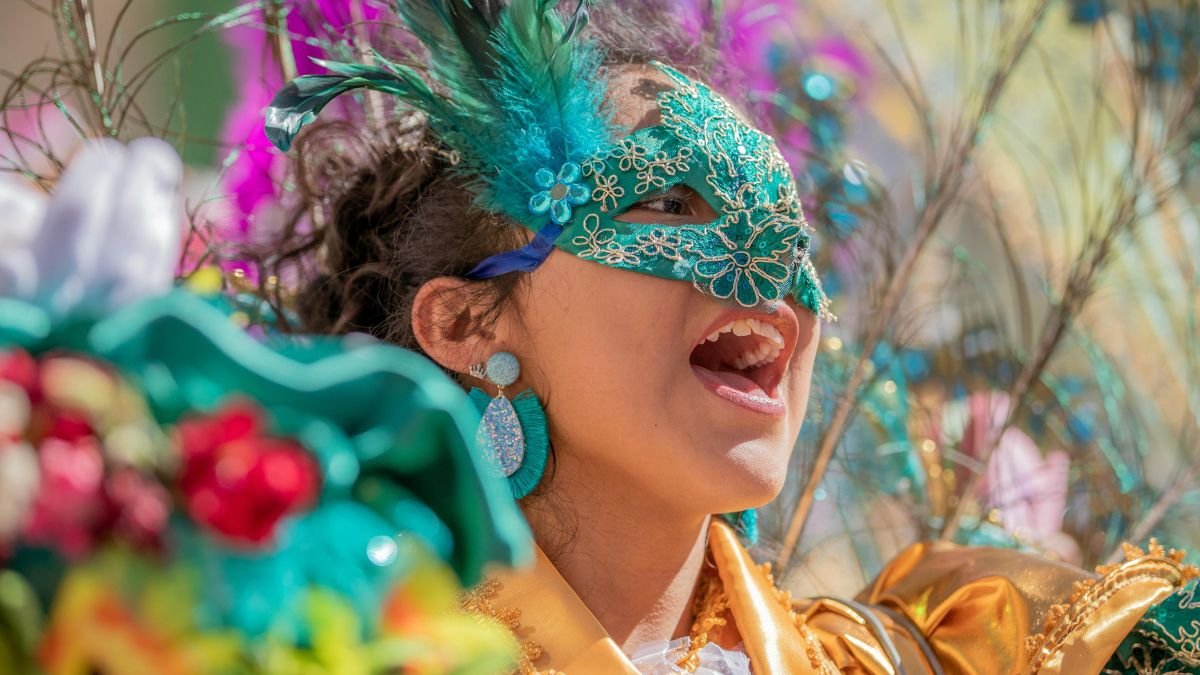Introduction
When you think of vibrant celebrations, does your mind immediately jump to Rio’s Carnival? While it’s undeniably spectacular, showcasing a dazzling array of samba parades and colorful costumes, this South American gem offers so much more than just this iconic event. What if we told you there’s a world of lesser-known but equally dazzling Brazil festivals waiting to be explored, each reflecting the rich cultural heritage and diversity of Brazil?
From the lively streets of Salvador during the Festa de Iemanjá to the enchanting celebrations of Festa Junina in the countryside, there are countless opportunities to experience the joyous spirit of Brazilian culture. Each festival brings its own unique traditions and flavors, inviting both locals and visitors to immerse themselves in the vibrant atmosphere.

The country’s cultural tapestry is woven from indigenous roots, European influences, and African rhythms. From the Amazon’s mystical rituals to the German-inspired Oktoberfest in the south, every region adds its own flavor to the mix. Even globally recognized events like Rock in Rio started here, proving its impact on the world stage. These experiences are just a glimpse into the vibrant world of Brazil Festivals.
Ready to discover seven unforgettable experiences that redefine what traditions mean? Let’s dive into a journey where music, costumes, and history come alive in ways you’ve never imagined.
Key Takeaways
- Brazil’s festivals extend far beyond Carnival, offering a year-round cultural immersion experience.
- Each event reflects a unique blend of indigenous, European, and African influences.
- Regional diversity shines through Amazonian rituals, southern Oktoberfest, and northeastern folklore.
- Global phenomena like Rock in Rio highlight the country’s festival influence.
- Seven standout celebrations offer in-depth explorations of local traditions and music.
1. Blumenau’s Oktoberfest: A Bavarian Celebration in Brazil
Imagine sipping German beer while samba rhythms blend with polka tunes. This unique fusion comes alive in Blumenau, home to the world’s second-largest Oktoberfest. Every year, this city transforms into a Bavarian wonderland, drawing over 700,000 visitors to its 17-day celebration.
The festival, which started in 1984, has grown exponentially, showcasing not only the rich German heritage but also the vibrant Brazilian spirit that infuses every aspect of the event. Visitors can expect a delightful mix of traditional German music and lively samba performances, creating an atmosphere that is both festive and culturally enriching.
German Roots in Southern Brazil
Founded by 19th-century immigrants, Blumenau’s architecture bears a resemblance to Germany’s half-timbered houses. The local culture preserves traditions like dirndls, lederhosen, and brass bands. Yet, it adds a Brazilian twist, think feijoada served alongside schnitzel.
This blend of cultures is not just about food; it extends to the music, dance, and overall celebration of life that characterizes the festival. Local artisans showcase their crafts, further enriching the experience and providing a platform for cultural exchange.
Festival Highlights: Beer, Costumes, and Traditions
The event kicks off with a parade featuring 100+ floats and 15,000 participants in vibrant costumes. Key experiences include:
- Beer gardens offering 400+ draft varieties, including local craft beers that highlight the region’s brewing expertise
- Cultural mashups like samba dancers to polka beats, creating an exhilarating atmosphere that captivates audiences
- German-Brazilian fusion food stalls, featuring innovative dishes that combine traditional recipes with local ingredients
In 2023, the festival contributed $50 million to the regional economy, underscoring its importance not only as a cultural event but also as a significant economic driver for the area. For an authentic taste of this hybrid celebration, explore the Oktoberfest of Blumenau.
The festival stands as a testament to the enduring legacy of immigration and cultural fusion, inviting everyone to partake in this joyous celebration of heritage and community.
2. Parintins Folklore Festival: Amazonian Legends Come Alive
Deep in the Amazon, a cultural showdown unfolds under starlit skies, creating an atmosphere filled with excitement and anticipation. The Parintins Folklore Festival transforms this riverside town into a vibrant stage for the Boi-Bumbá legend, a rich tapestry of folklore that celebrates the region’s indigenous heritage.
For three thrilling nights, two rival teams, Caprichoso (the blue bull) and Garantido (the red bull), battle fiercely through mesmerizing dance, enchanting music, and jaw-dropping floats that dazzle the audience with their intricate designs and vivid colors.
The Battle of Caprichoso vs. Garantido
This electrifying event is more than a competition; it’s a theatrical retelling of Amazonian creation myths that captivates audiences worldwide. Each team spends over $5 million annually on costumes and 40-foot floats, showcasing their dedication to this vibrant cultural heritage.
The toada music, sung in indigenous dialects, drives the narrative, intertwining the past with the present and bringing the legends of the Amazon to life through rhythm and melody.
Key highlights of the rivalry:
- Cunhã Poranga: A dance honoring indigenous women, featuring 200+ performers in feathered headdresses, each representing a unique aspect of their culture and history, symbolizing strength and resilience.
- Elaborate parades depict jaguars, river deities, and forest spirits, showcasing the rich biodiversity of the Amazon and the deep spiritual connection the local communities have with their environment.
- Judges score teams on choreography, music, and crowd energy, ensuring that every aspect of the performance is celebrated, from the intricate dance moves to the heartfelt lyrics that resonate with the audience.
- In addition to the competition, the festival serves as a unifying force for the community, fostering a sense of pride and cultural identity among both participants and spectators. Judges score teams on choreography, music, and crowd energy.
Where to Experience the Bumbódromo Spectacle
The festival takes place in a 35,000-seat arena modeled after Rio’s Sambadrome. For the full experience:
- Best seats: Sections A or B for unobstructed views of the floats.
- Local stays: Homestays with local families offer an authentic immersion experience.
- Travel tip: Fly from Manaus (2 hours) and book tickets early—this rare in the country spectacle sells out fast.
Mark your calendar for June 28–30, 2024, when the festivities peak under the Amazonian full moon.
3. Festa Junina: A Traditional Brazil Festivals and Vibrant Rural Winter Celebration
June nights in the countryside come alive with folk music and towering bonfires, creating a magical atmosphere that draws both locals and visitors into the celebration. Originating from the Portuguese St. John’s Feast, this event blends Catholic reverence with pagan fire rituals, symbolizing the triumph of light over darkness during the winter solstice.
Locals leap over flames for luck, a tradition echoing centuries of cultural fusion, where each jump is not just a display of bravery but a way to invoke blessings for the coming year. The festival is a time for families to gather, share stories, and partake in age-old customs that strengthen community bonds.

Quadrilha Dances and Bonfire Rituals
The *quadrilha* dance steals the spotlight. Couples mimic playful wedding scenes, guided by a caller’s rhythmic commands that echo the lively spirit of the festival. Each step is choreographed to reflect traditional courtship rituals, showcasing not only skill but also the joy of community participation.
Straw hats and checkered shirts add a rustic charm, while forró music keeps feet moving until dawn, creating an infectious energy that encourages everyone to join in. This dance is more than just entertainment; it serves as a cultural expression that unites generations, preserving the region’s heritage.
Food plays a starring role in the festivities, offering a taste of local traditions:
- Pamonha: Sweet corn paste wrapped in husks, a beloved treat that embodies the essence of the harvest season.
- Canjica: Creamy coconut porridge topped with cinnamon, a comforting dish that warms the soul and is often enjoyed during communal gatherings.
- Caipirinhas: Served in clay pots for an earthy twist, these refreshing cocktails made from sugarcane liquor are a favorite among festival-goers, enhancing the celebratory atmosphere.
Best Places to Celebrate in the Northeast
Campina Grande hosts the Maior São João do Mundo (World’s Largest). Its 30-meter bonfires draw 2.5 million visitors over 30 days, making it a central hub for cultural exchange and celebration. Nearby Caruaru boasts over 450 food stalls, perfect for sampling regional treats that showcase the diverse culinary landscape of the Northeast.
| City | Highlights | Best For |
| Campina Grande | Giant bonfires, parades | Large-scale celebrations |
| Caruaru | Food stalls, crafts | Authentic flavors |
| Bahia | Beachside parties | Scenic trip combos |
Pro tip: Pack a jacket, June nights in Bahia dip to 60°F. Pair it with dancing to stay warm and immerse yourself fully in the vibrant atmosphere!
4. Réveillon: Rio’s Epic New Year’s Eve on Copacabana Beach
Rio de Janeiro’s New Year’s Eve isn’t just a party—it’s a spiritual spectacle fused with explosive energy. Two million people flood Copacabana Beach, dressed head-to-toe in white to honor Iemanjá, the Afro-Brazilian sea goddess.
This vibrant tradition reflects the deep cultural roots and reverence for the ocean, as participants believe that offering flowers and other gifts to Iemanjá brings blessings for the coming year. As fireworks erupt from eight barges, the Atlantic Ocean mirrors the sky’s kaleidoscope, creating a breathtaking display that captivates everyone present.
The atmosphere is electric, filled with joy, laughter, and the rhythmic sounds of samba music, as people celebrate with friends and family, welcoming the new year with open hearts and hopeful spirits.

Fireworks, Music, and All-White Attire
The 15-minute pyrotechnic show is synchronized to live performances by stars like Anitta and Ivete Sangalo, creating a mesmerizing experience that resonates with the crowd. White attire symbolizes peace and purity, representing the hopes and dreams of the participants for the upcoming year. At the same time, revelers toss flowers into the waves as offerings to Iemanjá, the sea goddess, in a heartfelt gesture of gratitude and respect. Key traditions include:
- Candomblé rituals: Yellow roses symbolize prosperity, while white candles represent healing, and other symbolic items are used to invoke blessings and protection for the year ahead, deeply rooted in Afro-Brazilian culture.
- 7-km “Corridor of Happiness”: 200 food vendors serving tapioca crepes, caipirinhas, and a variety of local delicacies, ensuring that the celebration is not just a feast for the eyes but also for the palate, allowing attendees to indulge in the flavors of Brazil.
- Paid vs. free zones: VIP areas with seating start at $150; free spots fill by 8 PM, providing options for everyone, from those seeking comfort to those looking to enjoy the event in a more communal setting.
Why It’s a Must-Attend Event
This globally renowned event seamlessly blends culture, music, and myth, drawing people from all corners of the globe to participate in this unique celebration. Hotels hit 98% occupancy, so book early to secure a spot in this vibrant city. Metro lines run until 4 AM, easing post-celebration commutes and allowing revelers to continue the festivities well into the night.
“Réveillon is where the world unites—under fireworks, in white, with hope for the year ahead, as strangers become friends and the spirit of celebration transcends all boundaries.”
| Viewing Area | Perks | Best For |
| VIP Sections | Seats, restrooms, bars, and a more exclusive experience | Comfort seekers |
| Free Beach Spots | Authentic crowd energy, mingling with locals and tourists alike | Budget travelers |
| Near Posto 5 | Easy metro access makes it convenient for families and groups | Families |
Pro tip: Arrive by 6 PM to claim space, as the beach fills quickly with eager attendees. Pack light—bags are screened at entry points to ensure safety and security. It’s the perfect way to ring in the new year amid Rio de Janeiro’s electric vibe, creating memories that will last a lifetime.
5. Rock in Rio: The World’s Largest Music Festival
The roar of guitars echoes across a 300-acre desert, where music history is rewritten every few years. Rock in Rio isn’t just a festival—it’s a cultural earthquake that has transformed the music landscape.
Since its inception in 1985, it has hosted legends like Queen and Beyoncé while boosting local economies by billions, creating a lasting legacy that resonates well beyond the stages. Each iteration brings together a diverse array of genres and artists, reflecting the evolving tastes of music lovers worldwide.
From Queen to Coldplay: Legendary Performances
Queen’s 1985 debut here became iconic, with Freddie Mercury rallying 250,000 fans in a performance that is still celebrated today. In 2013, Beyoncé’s halftime show broke streaming records, showcasing her unparalleled talent and stage presence.
The 2024 lineup features an exciting mix of global superstars like Bruno Mars, Ed Sheeran, and Brazilian star Ludmilla, ensuring that the festival continues to attract massive crowds and generate buzz. The anticipation surrounding each year’s lineup builds excitement, drawing fans from around the globe.
Emerging talents shine on the Força Stage, a dedicated platform for local artists to showcase their skills. This initiative not only highlights the richness of Brazilian music but also provides a launchpad for these artists to gain international recognition. Past winners of this stage have gone on to headline global events, proving that Rock in Rio is a vital part of the music ecosystem.
How the Festival Crossed Borders
What started in Rio now dominates the world, inspiring similar festivals across the globe. Lisbon (2004) and Las Vegas (2015) adopted the format, but the original’s 300-acre City of Rock remains unmatched in its scale and vibrancy. Key contrasts between the locations highlight the unique atmosphere each brings:
| Venue | Capacity | Unique Features |
| Rio de Janeiro | 1.5M (7 days) | 85% waste recycling, 40+ food trucks offering diverse culinary delights |
| Las Vegas | 80,000/day | VIP sky decks, shorter runtime that focuses on a more curated experience |
“Rock in Rio proves music can bridge continents—it’s a blueprint for global unity, showcasing how art can bring people together, transcending language and cultural barriers.”
Pro tip: International fans should buy tickets early via the official site to secure their spot at this monumental event. Packages often include shuttle passes to the venue, making it easier to navigate the festivities and enjoy everything the festival has to offer.
Why Brazil Festivals Are More Than Just Parties
Brazil festivals reflect the country’s soul — a mix of joy, resistance, and unity that turns each celebration into a cultural statement
Conclusion: Explore Brazil’s Festivals Beyond Carnival
From the Amazon’s mystical legends to southern beer tents, these events showcase the country’s rich culture. Each celebration tells a unique story—whether it’s Parintins’ intimate folklore or Rock in Rio’s massive stages.
The Parintins Folklore Festival, for instance, not only entertains but also preserves and promotes indigenous myths, connecting attendees with the deep-rooted traditions of the Amazon.
Meanwhile, Rock in Rio attracts a global audience, blending international music with local artistry to create a vibrant tapestry of sounds and experiences that resonate across cultures.
Plan your trip around the seasons: June for Festa Junina’s bonfires, where you can savor traditional foods like pamonha and canjica, and enjoy lively quadrilha dances that bring communities together, October for Blumenau’s Oktoberfest, which celebrates German heritage with a Brazilian twist, featuring not just beer but also delicious local cuisine.
Pair festival visits with nature adventures in the Pantanal or Amazon for a full experience. Exploring the breathtaking landscapes and diverse wildlife of these regions can enhance your understanding of the cultural context behind the festivals, making your journey even more enriching.
Ready to dive deeper? These traditions offer more than spectacle; they’re gateways to understanding local life, history, and the values that shape Brazilian society. Each festival is an invitation to immerse yourself in the rhythm of the country, so pack your bags and join the rhythm! Learn more about Brazilian culture.
FAQ
What makes Blumenau’s Oktoberfest unique in Brazil?
Blumenau’s Oktoberfest blends Bavarian traditions with Brazilian flair, featuring beer tents, folk dances, and colorful costumes. It’s the largest German-themed festival outside Germany.
How does the Parintins Folklore Festival showcase Amazonian culture?
The festival brings Amazonian legends to life through elaborate performances, music, and a fierce competition between the Caprichoso and Garantido teams in the Bumbódromo arena.
What are the key elements of Festa Junina?
Festa Junina celebrates rural traditions with quadrilha dances, bonfires, corn-based treats, and festive attire. The Northeast hosts the most authentic celebrations.
Why is Rio’s Réveillon on Copacabana Beach so famous?
The event draws millions for its breathtaking fireworks, live music, and the tradition of wearing white for luck. It’s one of the world’s largest New Year’s Eve parties.
What sets Rock in Rio apart from other music festivals?
Rock in Rio features global superstars, from Queen to Coldplay, and has expanded internationally. Its massive scale and diverse lineup make it a bucket-list event.
When is the best time to experience these festivals?
Oktoberfest runs in October, Festa Junina in June, and Réveillon on New Year’s Eve. Parintins occurs in late June, while Rock in Rio dates vary; check schedules in advance.
Are these festivals family-friendly?
Yes! Festa Junina and Oktoberfest are great for families, while Réveillon and Rock in Rio cater more to adults. Parintins offers a mix of theatrical and cultural experiences.




